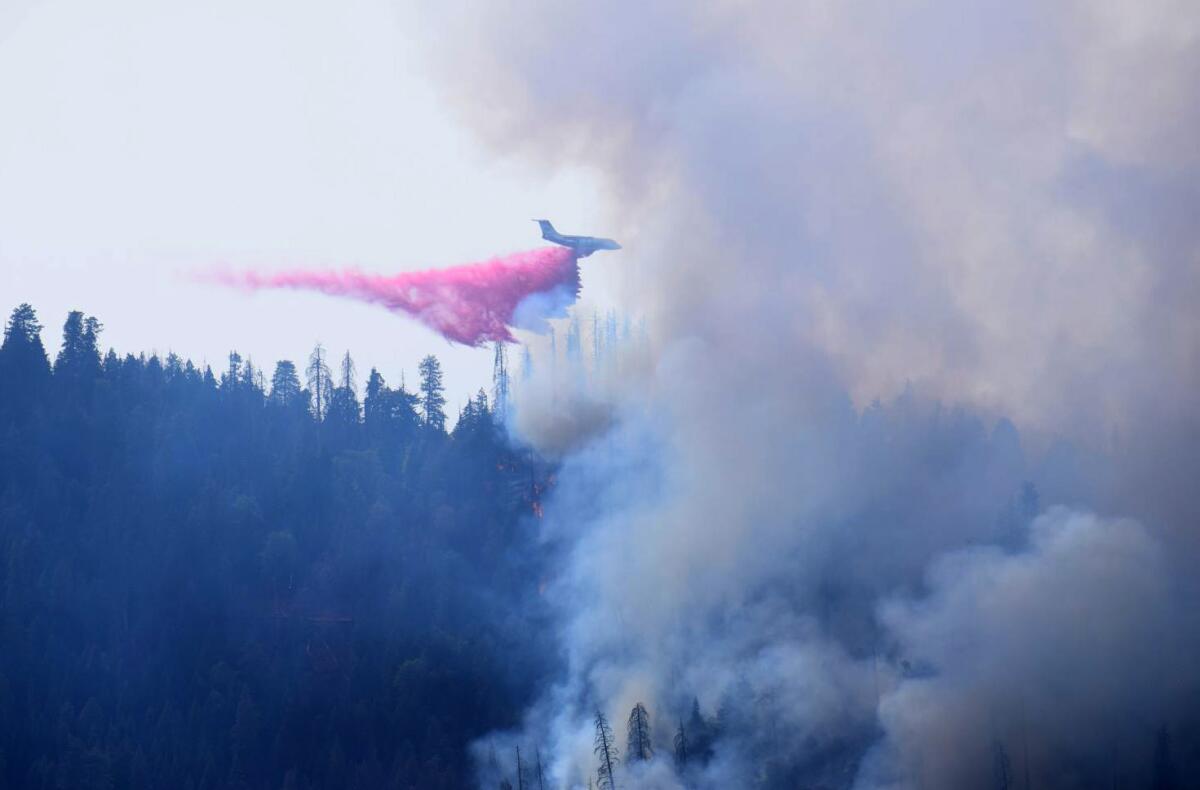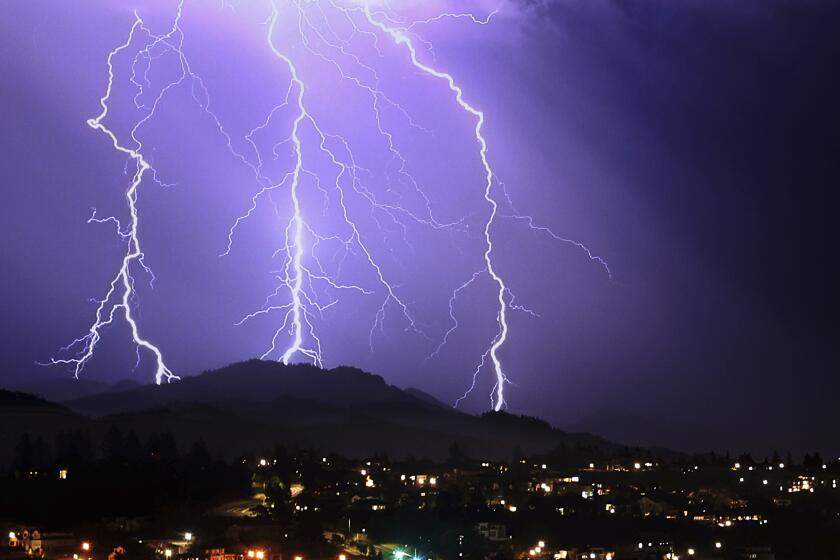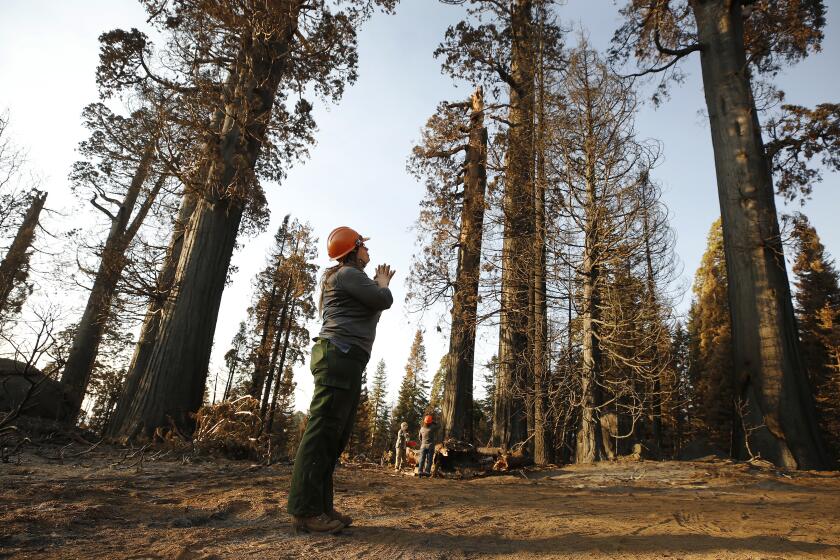Wildfires rage in Sequoia National park and forest, sending flames into grove of giant trees

- Share via
A pair of lightning-sparked fires that took hold in rugged terrain in the Sequoia and Kings Canyon national parks exploded over the weekend, while another blaze to the south burned into a grove of giant sequoia trees, sending smoke billowing above popular tourist destinations and forcing closures in the area.
All three fires ignited Thursday after a series of thunderstorms rolled in, sending more than 130 lighting strikes into the southern Sierra Nevada mountains and sparking the Paradise and Colony fires in the two parks. Collectively called the KNP Complex, the fires have since seared 1,037 acres with no containment, forcing the closure of the Sequoia National Park while the Kings Canyon side remained open, according to Mark Ruggiero, a public information officer for the national parks.
A separate blaze, dubbed the Windy fire, had seared 974 acres in the adjoining Sequoia National Forest. It had burned into the Peyrone Sequoia grove, part of the Giant Sequoia National Monument, according to Kate Kramer, a spokesperson for the fire.
In an effort to tamp down fire risk, all national forests in California — including Sequoia — were closed last month, with closures slated to last at least through Sept. 17.
Flames were in the perimeter of the towering trees — which can rise more than 250 feet and live for 3,000 years — but it wasn’t immediately known whether the fire had felled any, Kramer said, adding, “The fire is already into the grove.”
The national parks also contain groves of giant sequoias, including the 275-foot tall General Sherman tree, considered the largest tree in the world by volume. Although the fires are not near the General Sherman tree or any of the other groves of giant redwoods, they are considered a “threat” to the sequoias, Ruggiero said.
“The potential is there, with the current climate and how fires have been burning these last two years,” he added. Last year’s Castle fire destroyed hundreds of towering sequoias.
Ruggiero said the giants were naturally fire-adaptive trees and need fire to reproduce. But the ferocity of recent fires is actually stymying growth. “The fires are burning so intense,” Ruggiero said, “that it’s really affecting the sequoia population.”
Lightning lit up the sky across California on Thursday night, sparking new fires from Mendocino to El Dorado counties. And the Dixie fire continued to grow.
The Paradise fire, burning south of the Buckeye Flat Campground, ballooned to 807 acres while the Colony fire, west of Crystal Cave Road, grew to 230 acres. Given the challenging terrain — with the Paradise fire raging at an elevation of 5,000 feet — crews attacked it from the air, officials said.
“We’ve been painting the mountains red with retardant the last couple of days,” Clay Jordan, park superintendent, said during a community meeting. “So we hit that very aggressively.”
Mandatory evacuations were issued for the Silver City and Cabin Cove area on Mineral King Road, with the the Exeter Veterans Memorial Building serving as a temporary evacuation point, the Tulare County Sheriff’s Office said.
The fires are also threatening the foothills community of Three Rivers, portions of which are under an evacuation warning.
The Windy fire ignited in the Tule River Indian Reservation before pushing into the national forest, where it’s rapidly spreading south and east through dead timber and other dry vegetation, Kramer said. Rain dropped by the recent storms is gone, and it’s getting drier and hotter again — conditions that promote fire growth.
Like the KNP Complex to the north, the Windy fire has been difficult to attack, with its location amid difficult terrain and intense fire behavior. The flames are backing downhill, and there are roll-outs — when a burning log tumbles down, Kramer said.
“This fire has a great resistance to control,” she said.
This year’s Castle fire killed hundreds of giant sequoias, the latest in a string of Sierra Nevada wildfires that is taking an alarming toll on the world’s most massive trees.
Elsewhere in Northern California, firefighters appeared to be turning a corner of the monstrous Dixie fire, which has seared more than 960,000 acres across multiple counties north of Sacramento since igniting in Plumas County about two months ago.
Fewer than 100,000 acres shy of becoming the largest blaze in California history, the Dixie fire last week exploded along the northwest portion, spurring the evacuation of several rural communities as the flames lapped closer.
But by Monday morning, the blaze was 75% contained, representing an increase of 16% since Friday.
Containment of the nearly 220,000-acre Caldor fire tearing through El Dorado County also improved and was at 67% on Monday morning.
With fuels across the state critically dry amid years of relentless drought, fire continue to ignite and surge at rapid speeds.
Elsewhere in Northern California, lightning brought by intense storms cells ignited fires from El Dorado to Mendocino counties, as it hit historically dry fuels.
A fast-moving fire burned some structures Sunday afternoon near Lake Mendocino and prompted evacuations, officials said.
The Hopkins fire that ignited Sunday in Mendocino County has seared just over 250 acres near the town of Calpella, north of Santa Rosa, and is 20% contained, according to the California Department of Forestry and Fire Protection.
Social media posts showed the fire engulfing some structures. As an assessment of the damage is underway, the fire continues to threaten about 200 structures, according to a report by Cal Fire. Its cause is under investigation.
Lower overnight temperatures and a boost in humidity helped firefighters get a handle on the blaze and increase containment, fire officials said.
A brush fire that erupted late Saturday afternoon and temporarily shut down the 5 Freeway in both directions near Castaic had grown to 462 acres by Monday and was 63% contained. Flames were visible along the roadway as what was dubbed the Route fire grew at a moderate speed through chaparral.
Southbound lanes on the 5 were reopened, and northbound lane closures were set to lift at 7 p.m. Monday, according to a recent incident report.
More to Read
Sign up for Essential California
The most important California stories and recommendations in your inbox every morning.
You may occasionally receive promotional content from the Los Angeles Times.













